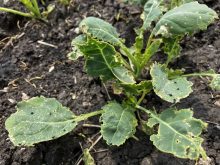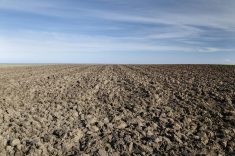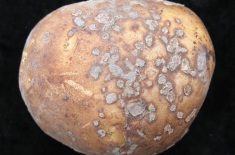Winter wheat harvest has begun in Manitoba and planting won’t be far behind.
It’s too early to say how well this year’s crop will yield, but winterkill and fusarium head blight are taking a toll. But there are things farmers can do when seeding this year’s crop to try and mitigate the impact on 2015’s crop, says Ken Gross, agronomist with the winter wheat initiative and Ducks Unlimited Canada.
Seeding winter wheat early into good standing stubble can improve its winter survivability, while shallow, even seed placement and upping the seeding rate can produce a more even crop making it easier to protect from fusarium with a fungicide.
“I’ve seen guys get away with seeding on pea stubble and seeding late many years,” Gross said Aug. 6 during the Crop Talk Westman webinar put on by Manitoba Agriculture, Food and Rural Development. “This year (2013-14) we didn’t get away with it.”
Based on soil temperature measurements taken throughout the winter, Gross suspects much of the 2013-14 winter wheat crop that died was killed this spring.
Winter wheat is at its hardiest in December. Many fields were well insulated with snow then. As the season progresses winter wheat de-hardens. Fields that lacked snow because of poor stubble probably were “knocked off” during a cold snap in April, he said.

A lack of stubble could be a problem for farmers in western Manitoba planning to seed fields that were too wet to plant this spring. Even if there’s a good winter wheat stand before freeze-up, the winter wheat crop itself won’t catch much snow because it dies down to the ground, Gross said.
It’s important to preserve stubble, he added. If possible farmers can follow previous tractor tracks and use tall weeds to trap snow, Gross said.
The Manitoba Agricultural Services Corporation, which administers crop insurance, recommends seeding winter wheat in stubble, but it’s no longer a requirement to get coverage. The change came after MASC dropped Stage 1 coverage prior to June 20. As a result winter wheat growers only have a reseeding benefit should their crop fail before June 20.
Read Also

CUSMA access key among other trade noise: Seeds Canada panel
Seeds Canada conference panelists say Canada needs to stay focused and wait as U.S. trade and tariff chaos develops, and a Canada-U.S.-Mexico Agreement review looms
Seeding early, seed slow
Crop insurance seeding dates have not changed. To get full coverage farmers need to seed winter wheat between Aug. 20 and Sept. 15. Farmers can plant Sept. 16 to 20 with reduced coverage.
Earlier is better because ideally the crop should be in the three- to four-leaf stage going into winter, Gross said. Smaller plants don’t store enough nutrients and energy in their crowns, which help with stress and regrowth in the spring.
Seeding shallow — one inch deep — even in dry soil, results in quicker emergence (if it rains) and a more vigorous plant going into winter, he added.
“There is a yield penalty for seeding winter wheat deeper,” Gross said.
To ensure an even seeding depth Gross recommends planting at four miles per hour — similar to what’s suggested for canola.
“I know guys are in a hurry in the fall doing harvest at the same time but doing this a little bit more slowly will provide a yield benefit,” he said.
Winter wheat needs lots of nitrogen to yield well. Knowing the residual nutrient level in the soil is important, especially following excessive moisture and the only way to know is through a soil test, Gross said.
“Winter wheat sets its yield very early — by four- or five-leaf stage — so if you don’t have your nitrogen on by that stage and have it available to the crop you’re starting to lose yield,” he said.
“So getting some on in the fall is a good idea.”
There’s a risk of losing nitrogen before spring due to denitrification and/or volatilization. Ideally, spring-applied nitrogen should go on before winter wheat breaks dormancy.
ESN, a polymer-coated form of urea nitrogen, is a good way to prevent nitrogen losses, Agrium’s senior agronomist Ray Dowbenko told the webinar. Typically 35 to 40 per cent of fall-applied ESN is available to a winter wheat crop in the fall and the rest remains in the soil becoming available as the crop breaks dormancy in the spring.
All the nitrogen for a winter wheat crop can be applied in the fall as ESN forgoing the need to top dress with nitrogen in the spring, which is sometimes difficult because of wet conditions, Dowbenko said. Avoiding a second pass can save $6 to $8 an acre, plus wear and tear on equipment, “plus (avoiding) the agony of wondering it I’m going to get out there early enough,” he said.
ESN sells for a premium over regular urea. Each farmer has to make up his or her own mind if the extra cost is worth it, Dowbenko said.




















